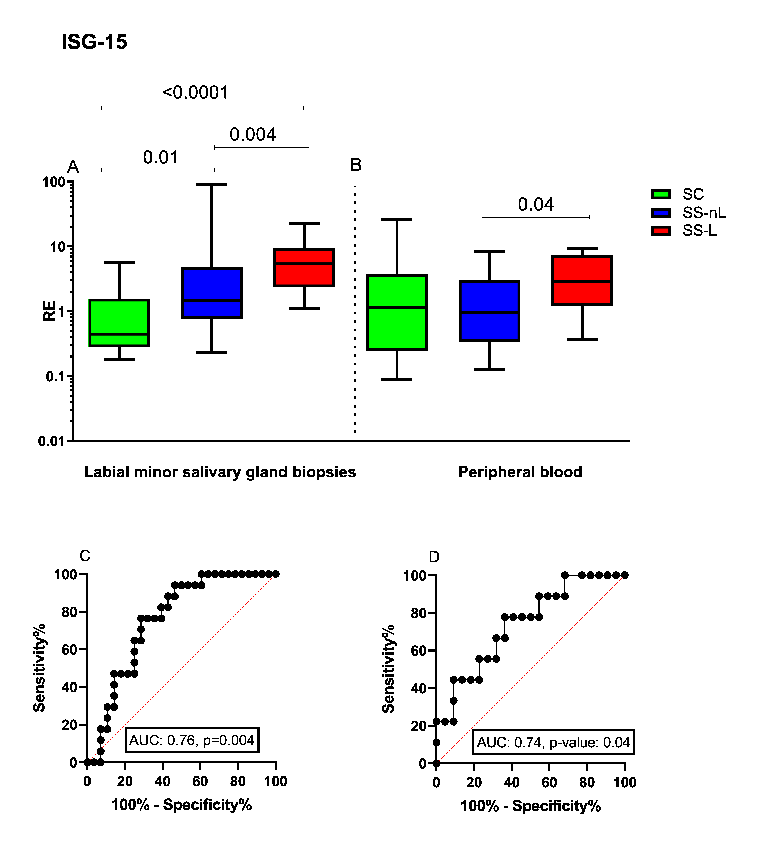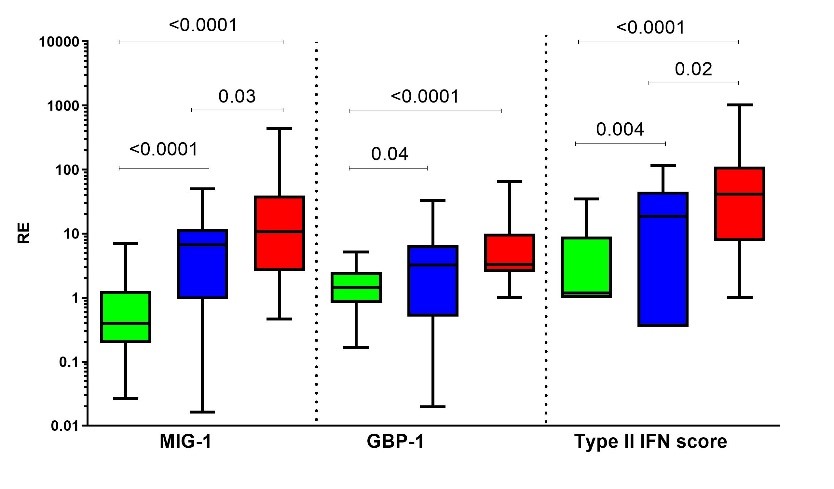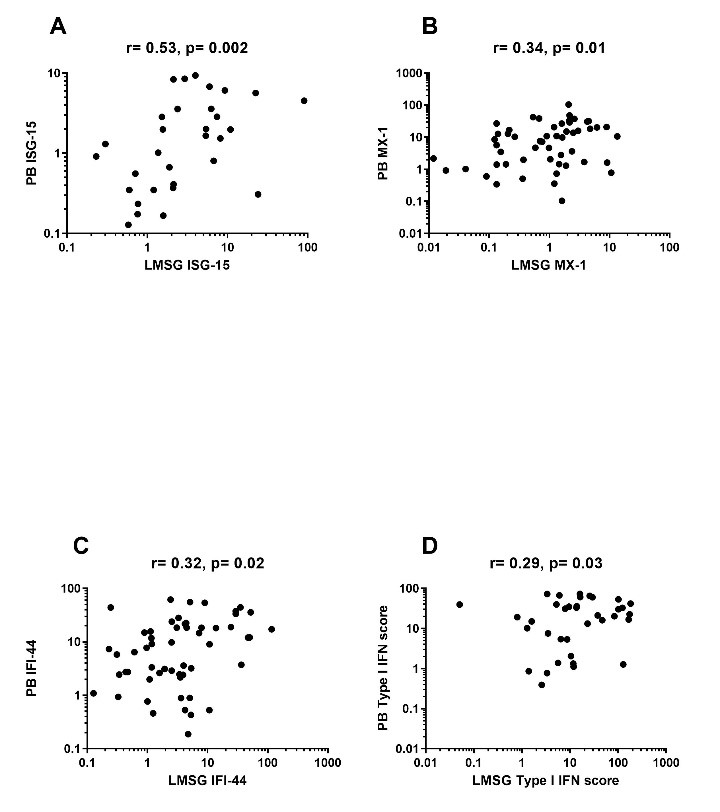Session Information
Date: Tuesday, November 9, 2021
Title: Abstracts: B Cell Biology & Targets in Autoimmune & Inflammatory Disease (1905–1908)
Session Type: Abstract Session
Session Time: 2:45PM-3:00PM
Background/Purpose: Primary Sjögren’s syndrome (SS), an autoimmune exocrinopathy, is expressed either as a local disease or as a systemic illness with an enhanced risk for the development of lymphoma. Several clinical, laboratory, histopathological and molecular markers have been identified, but the pathogenetic pathway of lymphoma development remains to a large extent unknown. We investigated whether interferon (IFN) induced genes could serve as biomarkers for the detection of lymphoma development among patients with SS.
Methods: Total RNA was extracted from 98 labial minor salivary glands (LMSG) biopsies of SS patients [61 not complicated by lymphoma (SS-nL) and 37 complicated by NHL (SS-L)] and from 67 matched to LMSG biopsies peripheral blood (PB) samples. Additionally, 30 LMSG biopsies and 17 matched PB of patients presenting with subjective dry eyes and/or dry mouth symptoms without fulfilling SS classification criteria (sicca controls, SC) were implemented. RNA sequencing was performed in total RNA extracted from 6 LMSG biopsies of 5 SS patients (2 at high risk and 3 at low risk for lymphoma development) and one SC. Expression analysis of type I (MX-1, IFIT-1, IFI44 and ISG-15) and type II IFN induced (CXCL9/MIG-1, GBP-1) genes was performed by real time PCR.
Results: Genes preferentially induced by type I IFNs including MX-1, IFIT-1 and IFI44 as well as ISG-15 and the type II IFN induced CXCL9/MIG-1 gene were up-regulated in “high risk” SS patients by next-generation sequencing (NGS). ISG-15 transcript levels measured by quantitative real time PCR were also higher in SS patients complicated by lymphoma (SS-L), compared to SS patients without lymphoma (SS-nL) in both LMSG tissues and PB specimens (mean ± SD: 6.6 ± 5.4 vs 6.3 ± 17.1, p = 0.004 and 4.2 ± 3.4 vs 1.9 ± 2.2, p = 0.04 respectively). ROC analysis revealed that both LMSG and PB ISG-15 gene expression has the potential to distinguish between SS-L and SS-nL patients (MSGB: AUC= 0.76, CI (95%): 0.62–0.90, p-value: 0.004 and PB: AUC= 0.74, CI (95%): 0.56–0.93, p-value: 0.04). (Figure 1) Only relative expression of MIG-1 and type II IFN score in LMSG tissues but not in peripheral blood were higher in SS-L patients compared to SS-nL patients (42.74 ± 93.18 vs 8.51 ± 9.95, p = 0.03 and 102.8 ± 205.2 vs 26.69 ± 30.27, p = 0.02, respectively) (Figure 2). Three of the genes preferentially induced by type I IFNs in LMSGs, ISG-15, MX-1 and IFI44, as well as type I IFN score in LMSG tissues were correlated with the corresponding values in PB (Spearman r = 0.53, p = 0.002, Spearman r = 0.34, p = 0.01, Spearman r = 0.33, p = 0.02 and Spearman r = 0.29, p = 0.03) (Figure 3). No other type I or II IFN inducible genes tested either at PB or LMSG level was predictive for lymphoma development in SS patients.
Conclusion: ISG-15 gene expression was able to distinguish SS-nL and SS-L at both periphery and tissue level and therefore could represent a novel biomarker for lymphoma development among SS patients. PB and LSMG seem to share a common transcriptional profile of type I IFN pathway.
 Figure 1. Relative expression of ISG_15 in 45 labial LMSG samples and 31 PB samples of SS patients and in 15 SC both in LMSG biopsies and PB samples.
Figure 1. Relative expression of ISG_15 in 45 labial LMSG samples and 31 PB samples of SS patients and in 15 SC both in LMSG biopsies and PB samples.
 Figure 2. Relative expression of type II IFN inducible genes in LMSG tissues samples of SS patients and SC
Figure 2. Relative expression of type II IFN inducible genes in LMSG tissues samples of SS patients and SC
 Figure 3. Correlation of relative gene expression in LMSG tissues and PB samples of type I and type II IFN induced genes.
Figure 3. Correlation of relative gene expression in LMSG tissues and PB samples of type I and type II IFN induced genes.
To cite this abstract in AMA style:
Cinoku I, Verrou K, Piperi E, Voulgarelis M, Moutsopoulos H, Mavragani C. Interferon (IFN)-Stimulated Gene 15: A Novel Biomarker for Lymphoma Development in Sjögren’s Syndrome [abstract]. Arthritis Rheumatol. 2021; 73 (suppl 9). https://acrabstracts.org/abstract/interferon-ifn-stimulated-gene-15-a-novel-biomarker-for-lymphoma-development-in-sjogrens-syndrome/. Accessed .« Back to ACR Convergence 2021
ACR Meeting Abstracts - https://acrabstracts.org/abstract/interferon-ifn-stimulated-gene-15-a-novel-biomarker-for-lymphoma-development-in-sjogrens-syndrome/
